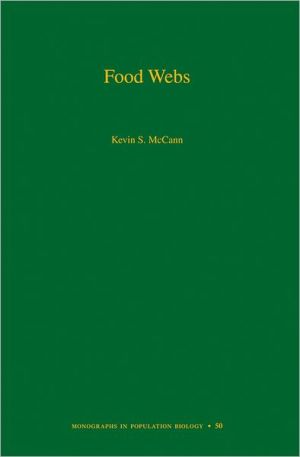

 |

|

Sold Out
Book Categories |
Preface xi Part 1: THE PROBLEM AND THE APPROACH
Chapter 1. The Balance of Nature: What Is It and Why Care? 3
1.1 Balancing a Noisy System 3
1.2 Ecosystem Stability and Sustainability 6
1.3 Of Food Webs, Stability, and Function 9
1.4 Ecological Instability and Collapse 10
1.5 A Theory for Food Webs 17
Chapter 2. A Primer for Dynamical Systems 20
2.1 Qualitative Approaches to Complex Problems 20
2.2 Dynamical Systems 22
2.3 Case Study: Hopf Bifurcation in an Aquatic Microcosm 42
2.4 Summary of Key Points 45
Chapter 3. Of Modules, Motifs, and Whole Webs 47
Part 2: FOOD WEB MODULES: FROM POPULATIONS TO SMALL FOOD WEBS
Chapter 4. Excitable and Nonexcitable Population Dynamics 53
4.1 Continuous Resource Dynamics 53
4.2 From Nonexcitable to Excitable Population Dynamics 56
4.3 Stage-Structured Resource Dynamics 61
4.4 Empirical Evidence for Excitable Dynamics 63
4.5 Summary: The Dual Nature of Population Growth Rates 65
Chapter 5. Consumer-Resource Dynamics: Building Consumptive Food Webs 67
5.1 Interaction Strength 67
5.2 Consumer-Resource Interactions: Two Qualitative Responses to Changes in a Parameter 71
5.3 Summary 79
5.4 Further Assumptions about the C-R Model 80
5.5 Some Nonequilibrium Thoughts 83
5.6 C-R Dynamics in Nature 84
5.7 Summary 88
Chapter 6. Lagged Consumer-Resource Dynamics 89
6.1 Discrete Consumer-Resource Interactions 90
6.2 Stage-Structured Consumer-Resource Dynamics 94
6.3 Stage-Structured Interactions and Alternative States 97
6.4 Empirical Results 100
6.5 Summary 101
Chapter 7. Food Chains and Omnivory 103
7.1 A Familiar Modular Example: Food Chains 105
7.2 Omnivory 110
7.3 Stage Structure and Food Chain Stability 116
7.4 Empirical Results 118
7.5 Summary 121
Chapter 8. More Modules 123
8.1 Generalists and Food Web Dynamics 123
8.2 The Diamond and the Intraguild Predator 132
8.3 Empirical Results 137
8.4 Summary 140
Part 3: TOWARD WHOLE SYSTEMS
Chapter 9. Coupling Modules in Space: A Landscape Theory 145
9.1 Variability, Space, and Food Webs 145
9.2 Individual Traits and a Landscape-Scale Module 147
9.3 Mobile Adaptive Consumers 151
9.4 Food Webs in Space 155
9.5 Asymmetric Flux Rates through Food Webs 160
9.6 Dynamical Implications on the Landscape 162
9.7 Empirical Evidence 164
9.8 Summary 169
Chapter 10. Classic Food Web Theory 170
10.1 The Classic Approach 170
10.2 Matrices and Local Stability 172
10.3 Gershgorin Discs for Community Matrices: An Intuitive Approach to Eigenvalues 172
10.4 A Controlled Approach to Food Web Matrices 175
10.5 Some Classic Whole-Matrix Results 178
10.6 Recent Whole Community Approaches 184
10.7 Summary 188
Chapter 11. Adding the Ecosystem 189
11.1 Grazing Food Webs and Whole Ecosystems 189
11.2 The N-R-D Module 192
11.3 Detritus and C-R Interactions 194
11.4 Nonequilibrium Dynamics and Detritus as a Distributor 197
11.5 Discussion 199
11.6 Summary 199
Chapter 12. Food Webs as Complex Adaptive Systems 201
12.1 Searching for Empirical Signatures 201
12.2 Adaptive Behavior, Changing Food Web Topology, and Ecosystem Size 202
12.3 Empirical Results for Canadian Shield Lake Ecosystems 206
12.4 Subsidies, Opportunists, and Homogenization 213
12.5 Humans in the Food Web 215
Bibliography 219
Index 235
Login|Complaints|Blog|Games|Digital Media|Souls|Obituary|Contact Us|FAQ
CAN'T FIND WHAT YOU'RE LOOKING FOR? CLICK HERE!!! X
 You must be logged in to add to WishlistX
 This item is in your Wish ListX
 This item is in your CollectionFood Webs (MPB-50)
X
 This Item is in Your InventoryFood Webs (MPB-50)
X
 You must be logged in to review the productsX
 X
 X

Add Food Webs (MPB-50), Human impacts are dramatically altering our natural ecosystems but the exact repercussions on ecological sustainability and function remain unclear. As a result, food web theory has experienced a proliferation of research seeking to address these critical, Food Webs (MPB-50) to the inventory that you are selling on WonderClubX
 X

Add Food Webs (MPB-50), Human impacts are dramatically altering our natural ecosystems but the exact repercussions on ecological sustainability and function remain unclear. As a result, food web theory has experienced a proliferation of research seeking to address these critical, Food Webs (MPB-50) to your collection on WonderClub |